Table of Contents
What’s the most challenging aspect of maintaining website performance? Is it the user interface? Or something else? The most crucial factor in any website’s performance is its backend. It enables a website to handle a high volume of traffic and ensure a seamless user experience. This is where the selection of backend frameworks becomes essential.
The backend framework you choose for your website development can significantly impact the scalability and performance of your site. Especially when a 1-2 second delay can cause a 4.42% drop in conversions, you need a website with a robust backend. However, most businesses struggle to find an optimal backend stack that can ensure 99.99% uptime for their website.
To address this, our experts have compiled a comprehensive list of the best backend frameworks available in 2026, ensuring a seamless user experience.

The Ultimate Checklist for Building An Incredible Web App
Get your free copy
Why are Backend Frameworks Essential for Web Development?
- They provide a better architecture to develop websites or an application.
- The framework helps you to write SQL queries faster and do not need to rewrite complete SQL Queries manually.
- They have a distinct architectural style. (for example, MVC), which results in code that is both usable and maintainable.
- Applications and websites can be developed efficiently.
- Using a framework you can develop with Less/No-code and you get more features.
10 Best Backend Frameworks for Web Development in 2026
- Django
- Ruby on Rails
- Laravel
- ASP.NET Framework
- CodeIgniter
- Flask
- Express.js
- Spring Boot
- NestJS
- Koa.js
1) Django for Python Development
Django was first released in July 2005 and is a Python-based open-source framework that encourages rapid development and clean, paradigm design. Built by experienced developers that handle a lot of the effort associated with web development, allowing you to concentrate on building your app without having to invent the wheel.
The most common language, Python, is all you need to know to create a project in Django. There is no need to learn structured query languages like SQL or NO-SQL as Python will take care of it.
Django enables developers to split projects into numerous applications, making it simpler for them to write code and reuse parts of it in other projects.
Django maintains the security and safety of your web app with its improved performance.
Some of the few famous companies using Django:
- Spotify
- Mozilla
- National Geographic
- Bitbuket
According to Github, Django has 84.7K stars and companies of all sizes, from small to large, are incorporating it into their stacks due to its growing popularity.
Benefits of Using Django
- Secure: In this day and age, tech professionals are very concerned about cybersecurity. Fortunately, Django’s security mechanism can guard against attacks like clickjacking, cross-site scripting, and SQL injection and promptly provides updated security fixes.
- Scalable: It is yet another benefit of utilizing Django to create web applications. Development can be scaled up or down, changing the number and complexity of Django components as necessary, depending on your particular product requirements.Django helps to maximize scalability and save web hosting costs by handling traffic and mobile app API usage from over 400 million users.
- Good Documentation & Tutorials: Django has good documentation and tutorials available. The quality of the official Django documentation is quite good. The framework has excellent community support, and many developers are available to assist newbies.
- Rapid Development: Django allows developers to develop applications as quickly as possible. We can work on many components simultaneously and integrate them much more effectively thanks to Django’s MVT framework. Additionally, Python code is straightforward to write and doesn’t require a lot of rules.
- Versatile: Django is capable of handling everything; from controlling scientific computing platforms to managing content management systems. Everything falls under the umbrella of Django.
Features of Django
- Object Relational Mapper: Django ORM feature makes the developer’s work easy. As a developer, you only require basic knowledge of SQL. Also, record database management is made simple using ORM.
- Fully Loaded: Django offers a wide range of features, including user authentication, sitemaps, content management, RSS feeds, robust design, rapid software development, and many more.
- Free Flow Coding: Unlike other frameworks, Django doesn’t import any packages. There are no imports or third-party libraries required because it is a complete package. Therefore, developers avoid application bugs before it goes live in the production environment because it doesn’t allow incorrect code or unwanted functions by default.
- Admin Interface: With Django’s admin interface you can regulate access for other users and manage your databases. Without the need for commands, a graphical user interface can carry out the necessary CRUD (Create, Read, Update, Delete) operations.
- Batteries: Django adopts a “batteries included” approach. For daily tasks and requirements like security, database manipulation, session management, HTML templating, URL routing, and more, it offers predefined codes. As a result, the overall amount of time needed for web development is drastically reduced.
2) Ruby on Rails for Ruby Development
Ruby on Rails (or Rails) is a free and open-source web app development framework written in Ruby programming language. It was first released in August 2004.
Technically speaking, it is described as a RubyGem package library that is installed through the operating system’s command line interface. The framework offers developers a quicker way to write code. It is a group of code libraries that provide a ready-made solution for regular chores like creating tables, forms, or menus for the website.
It uses Ruby as well as JavaScript, HTML, and CSS to create web applications that run on a web server. Ruby on Rails is a back-end or server-side web application development platform since it operates on a web server.
Ruby on Rails is comparable to Python on Django or PHP on Laravel and Symfony. Underneath the language’s elegance and brevity, developers find that Ruby on Rails has a lot to offer. It is intended to assist agile development and give development teams productivity and flexibility. Additionally, it stands as the most popular backend technology for WEB3 development.
Some of the few famous companies using Laravel:
- Bloomberg
- Dribble
- Fiverr
- Couchsurfing
According to Github, Ruby on Rails has 57.7K stars and companies of all sizes, from small to large, are incorporating it into their stacks due to its growing popularity.
Benefits of Using Ruby on Rails
- Code Quality: When compared to PHP or NodeJS, Ruby code from third parties is much superior in quality.
- Automated Testing: Ruby community is active in testing and test automation. This is incredibly valuable for delivering good quality software and is one of the reasons Ruby libraries are so good.
- Performance: High-performance applications can be created with Ruby on Rails software development. Developers can create apps that mimic the common architecture of the best applications in the market by adhering to the convention over configuration and don’t repeat principles.
- Large Community: On GitHub, Ruby on Rails programmers have one of the biggest communities and one of the biggest repositories. The Ruby on Rails community provides both theoretical and practical knowledge. There is sufficient documentation available for new developers to comprehend the Ruby on Rails development framework’s overall architecture.
- Cost Effective: One of the most commonly faced problems for startups is time and budget. Ruby on Rail is cost-effective as it is completely free and open-source. From the perspective of a developer, it is also simple to use. Since there are so many gems (plugins) available, ruby has the advantage of saving developers a tonne of time and effort.
Features of Ruby on Rails
- MVC Architecture: Model, View, and Controller is the widely used web application architecture on which Ruby on Rails is based. Therefore, Ruby on Rails can be used easily by developers who are familiar with working with other frameworks that employ MVC principles. With this architecture, the presentation layer, data layer, and resource layer maintenance codes are separated.
- Active Record: Ruby on Rails relies on a powerful library called active record which makes it simple for developers to design the database interaction queries. This is because they create the query in the Ruby programming language, which is then automatically translated into a SQL query that accepts the result and returns an object. It is quite rare to create a SQL query because the active record library can handle the majority of the work.
- Simple Testing Tool: Ruby on Rails comes with a unit testing setup called RSpec. You can use it to test the functions used in the application by calling each one separately because it is just ordinary Ruby. You can use it to make sure your application has undergone sufficient testing.
- Convention Over Configuration: To keep conventions, reflection, and dynamic runtime extensions, Ruby on Rails does not use configuration files. The “Convention over Configuration” philosophy advocates automatically assigning value without user input. The convention feature boosts productivity because it eliminates the need for a lengthy configuration file setup.
3) Laravel for PHP Development
The public release of Laravel was in the year 2011 and since then it is one of the most popular PHP frameworks. There are around 1,14,640+ active Laravel websites. Laravel is a web development framework that is simple and elegant, because of its clean and comprehensive syntax, which combines Model-view-controller architecture to develop web applications.
Laravel, for example, gives us a syntax that is both expressive and elegant. Laravel turns development into a fun, creative, and enjoyable process. Laravel is a useful framework that makes basic operations like routing, authentication, sessions, and caching much easier. It’s not only accessible, but it also comes with a set of strong tools for building large, stable applications.
A flawless, simple syntax that enables the creation of high-performing web applications suggests that Laravel, in 2026 and beyond, is promising.
Some of the few famous companies using Laravel:
- MasterCard
- Razorpay
- Kmong
- Bitpanda
According to Github, Laravel has 82.4K stars and companies of all sizes, from small to large, are incorporating it into their stacks due to its growing popularity.
Benefits of using Laravel
- Flawless User Authentication and Authorization: One of the key Laravel benefits is its plug-and-play authentication methods, which enable users to safely access your resources through a lightning-fast, intuitive, elegant, and simple interface.
- Quick Caching Integration: Laravel quick or fast caching integration gives a stunning user experience on your website. Laravel supports in-demand backend caching like Memcached and Redis out of the box.
- Safe and Secure Transactions: When a business develops a website, then security is the prime concern and Laravel is best because of its built-in systems that protect against SQL injection, core site scripting, and more. Its codebase is frequently used, and as a result, it is well-protected.
- Open-source and Strong Community: Laravel is open-source and has a strong community that constantly supports developers and companies. As a result of the strong support you receive, your development work doesn’t stop.
- MVC Architecture: Because of MVC architecture that provides built-in functionalities, Laravel is the foremost framework to use for your web app development.
Features of Laravel
- Artisan Console: It is one of the best features of Laravel. Artisan, a built-in command-line tool in the Laravel framework, helps automate the majority of tedious repetitive programming processes.
- Libraries and Modularity: With its Object-oriented framework, Laravel is one of the best packages available. Several pre-installed libraries fully support modularity.
- Eloquent ORM: Eloquent Object Relational Mapping (ORM) is a Laravel feature that contains a simple PHP Active Record implementation. Instead of writing SQL code, web app developers can use PHP syntax to write database queries. In comparison to other PHP frameworks, ORMs are considerably faster.
- Unit- Testing: The Laravel framework can perform a large number of tests to ensure that the programmers’ new changes do not break anything in the web app unexpectedly.
- Template Engine: The Laravel framework is well-known for its lightweight templates, which can be used to build stunning layouts with dynamic content seeding.
4) ASP.NET Framework for .NET Development
In 2002, Microsoft introduced ASP.NET as a software framework. It is abbreviated as dot net and includes several coding languages, libraries, and editors. The ASP.NET framework allows you to create a wide range of applications like web apps, mobile applications, gaming, the cloud, the Internet of Things (IoT), etc.
ASP.NET software development framework and ecosystem allow quick development of desktop and web applications. It’s a popular free platform that’s now being used for a variety of applications because it provides the programming environment for the majority of software development phases. Businesses that want a wide range of functionality, such as web-based services, desktop software, and cloud infrastructure support, should use ASP.NET.
In the current era of website development, most famous companies are using the ASP.NET framework for developing web apps.
Some of the few famous companies using ASP.NET
- Accenture
- Stack Overflow
- Starbucks
- GoDaddy
- Microsoft
According to Github ASP.NET has 21.6k stars and companies of all sizes, from small to large, are incorporating it into their stacks due to its growing popularity.
Benefits of using ASP.NET
- Requires less Code: An object-oriented programming that eliminates excess code and allows developers to write fewer lines of code. There is a lot of reusable code in ASP.NET, as well as a lot of reusable elements. This leads to less time spent and lower costs in developing apps.
- Object-Oriented: In the ASP.NET framework, everything you see is an object. As a result, you’ll have a powerful tool for not only accessing but also controlling your apps. This also makes responding to recurring events much easier.
- Caching: The caching system included in ASP.NET is incredibly reliable and simple to use.
- Easy Maintenance: With ASP.NET, creating and maintaining pages is easy. This is because the source code and HTML both are together.
- Saves Time: ASP.NET saves a lot of time as it removes a larger part of coding requirements. This means companies save time and apps’ time to market is shortened.
- Large Community: ASP.NET has a large community. Most companies and developers use the ASP.NET framework because of the high-level support from the community. With a large community, almost any problem may be solved with the help of other members.
Features of ASP.NET
- Common Language Runtime: This is the engine that is shared by all .NET languages, including C#, VB.NET, Managed C++, J#, and coming languages.
- Tool Support: To make the developer’s job easier, the CLR works in combination with tools like Visual Studio, compilers, debuggers, and profilers.
- Easy Debugging Support: The.NET IDE (integrated development environment) offers comprehensive debugging capabilities. When a run-time exception occurs, the program terminates, and the IDE highlights the line containing the error, as well as the specifics of the error and alternative solutions.
- Multi-Language Support: ASP.NET supports multi-language development by managing the compilers that convert source code to intermediate language (IL) and IL to native code, as well as ensuring program safety and security.
- Security: The CLR ensures system security by identifying users and code, as well as performing permission checks. The code’s identity can be determined, and authorization to access resources is granted accordingly. This level of security is a key feature of the.NET framework.
5) Codeigniter for PHP Development
Codeigniter is a PHP framework released on February 28, 2006, by EllisLab. It was created for web developers who want a simple and attractive toolset for building fully functional web apps. CodeIgniter is one of the most popular frameworks for building dynamic websites with PHP.
Codeigniter provides companies with well-organized documentation. It provides exceptional support and stability. It allows for a simple routing approach to be used. It also directs you to the cached website, which improves performance and loading time.
The framework provides complete freedom to the users, removing the need for them to rely on the MVC development paradigm. The best thing about CodeIgniter is that it allows third-party plugins to help with complex functionality implementation.
Some of the few famous companies using Codeigniter
- Ola
- Accenture
- Buffer
- SocialDog
- Saramin
According to Github Codeigniter has 18.2k stars and companies of all sizes, from small to large, are incorporating it into their stacks due to its growing popularity.
Benefits of Using Codeigniter
- Error Handling: A simple user interface is offered by Codeigniter to detect any errors or defects that may be hindering the website’s smooth operation and, as a result, harming the user experience.
- Hassle-free Migration: Codeigniter provides adequate migration support. CodeIgniter allows developers to migrate from one server to another when it comes to database updates and migration.
- Good Community Support: When it comes to advanced development services, a large number of skilled professionals are available to provide you with the finest-in-class support.
- Fast Development: The Codeigniter framework is best for fast development as it requires less code to develop a website.
- Simple and Easy to Use: The Codeigniter framework is simple and easy to use because of its easy interface. With Codeigniter, it is also easy to modify databases in different ways.
Features of Codeigniter
- Lightweight: Codeigniter’s fundamental system requires a relatively modest library. Other libraries can be added dynamically based on requirements. Because of this, the framework is quick and lightweight.
- Search Engine Friendly URLs: The multiple URLs that Codeigniter generates are clean and search engine friendly. Instead of using a normal query-based approach, it uses a segmented approach.
- Model-View-Controller: MVC provides a Test Driven Development, which implies that the developer may build and test modules precisely according to the requirements.
- Built-in Libraries: The framework provides built-in libraries that assist in doing all the tasks like email sending, manipulating images, HTML/text emails, etc.
- Data Transfer is Easy: With the Codeigniter framework transfer of data is easy without any loss of relevant data.
6) Flask
Flask, crafted by Armin Ronacher of Pocoo, a global community of Python enthusiasts established in 2004, originated as an April Fool’s joke that gained such popularity that it evolved into a genuine and significant application, as envisioned by Ronacher.
It falls under the category of microframework since it doesn’t necessitate specific tools or libraries.
According to Builtwith, below is the graph of Flash Usage Statistics.
According to GitHub, Flask has over 70,500 stars, indicating its widespread adoption across various industries.

Some of the few famous companies using Flask
- Samsung
- Netflix
- Zalando
- Airbnb
- Trivago
Benefits of using Flask
- Flask boasts an active community, continuously enhancing the framework.
- It maintains a lightweight design with built-in modules.
- Enables quick and easy application development.
- User-friendly interface makes it ideal for beginners.
- Advanced users can extend features through Flask’s extensions.
Features of Flask
- Development Server and Debugger: Flask includes a built-in development server and debugger.
- Integrated Unit Testing: It provides integrated support for unit testing.
- RESTful Request Dispatching: Flask supports RESTful request dispatching for efficient web service development.
- Jinja Templating: Utilizes Jinja templating for flexible and dynamic content rendering.
- Secure Cookies (Client-Side Sessions): Ensures security with support for secure cookies on the client side.
- WSGI 1.0 Compliant: Flask is 100% WSGI 1.0 compliant for seamless integration with web servers.
- Unicode-Based: Built on Unicode for handling diverse character sets.
- Complete Documentation: Offers comprehensive documentation for easy understanding and implementation.
- Google App Engine Compatibility: Flask is compatible with Google App Engine for versatile deployment options.
- Extendable Functionality: Extensions are available to easily extend the framework’s functionality.
7) Express.JS
ExpressJS, first released on May 22, 2010, is now on Version 0.12. StrongLoop managed it after its acquisition in June 2014. IBM took over StrongLoop in September 2015, and in January 2016, ExpressJS came under the NodeJS Foundation incubator.
It is a minimal framework that is easy to learn and widely used. With its robust features, it enables the swift creation of diverse web and mobile applications.
According to Builtwith, below is the graph of Express.js Usage Statistics
According to GitHub, Express.JS has over 68k stars, with several companies now using it for scalable backend capabilities.
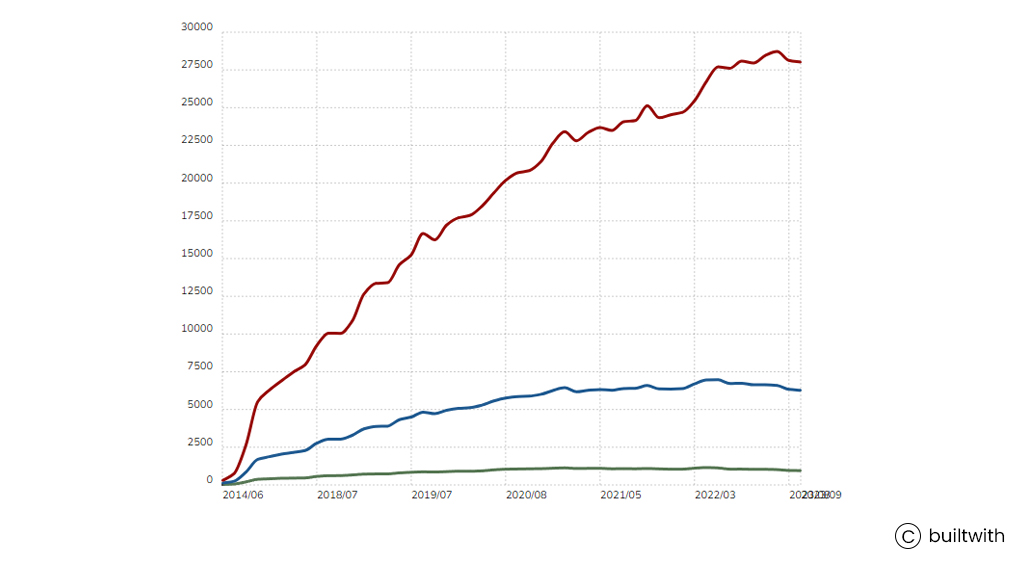
Some of the few famous companies using Express.js
- Countly
- Klout
- Storify
- MySpace
- LearnBoost
- Geeklist
Benefits of using Express.js
- Rapid Application Scaling: ExpressJS excels in swiftly scaling applications, leveraging additional support from Node, which further accelerates the scaling process.
- JavaScript Advantages: With both ExpressJS and NodeJS based on JavaScript, even non-technical individuals find it easy to learn. The popularity of JS simplifies backend development.
- Google’s V8 Engine Support: ExpressJS benefits from Google’s V8 Engine support, enhancing server-side development in web applications for improved performance and seamless processing.
- Community Backing: Express.js boasts a vibrant developer community actively contributing to its enhancement. Developers can tap into a diverse range of resources, tools, and frameworks.
- Speedy Development: ExpressJS facilitates quick, responsive, and sophisticated web application development by offering pre-made libraries, functions, and tools that expedite the process.
Features of Express.js
- Swift Server-Side Development: ExpressJS streamlines NodeJS features, easily accessible as functions for developers. This approach minimizes coding time, enhancing productivity.
- Middleware: Middleware in ExpressJS systematically organizes functions, granting access to client requests, databases, and other middleware.
- Integration: ExpressJS seamlessly integrates popular databases like MongoDB, MySQL, and PostgreSQL. Middleware or plugins facilitate CRUD tasks and database management.
- Advanced Routing: ExpressJS boasts an advanced routing mechanism, preserving web page state through URLs more effectively than other frameworks.
- Templating: The ExpressJS templating engine empowers backend developers to craft dynamic content on web pages using HTML templates.
- Security: Express.js prioritizes security with features like HTTPS support, CSRF prevention, and XSS protection, ensuring the creation of secure web apps.
- Debugging: ExpressJS offers accessible and advanced debugging tools, crucial for pinpointing specific components with bugs during web application development.
8). Spring Boot for Java Development
Boot, launched by Pivotal in 2014, has redefined how developers build and deploy production-ready Java applications. It simplifies the setup process through auto-configuration, starter dependencies, and embedded servers, enabling teams to focus on writing business logic rather than configuration.
Designed for microservices and cloud-native environments, Spring Boot allows developers to create independent, production-grade applications that run straight out of the box. With its built-in Actuator module, teams can easily monitor health, metrics, and application performance, making it ideal for enterprise-scale deployments.
Some of the leading companies using Spring Boot include:
- Netflix
- Amazon
- Microsoft
- Udemy
According to GitHub, Spring Boot has over 78.6k stars, indicating its widespread adoption in both enterprise and startup ecosystems.
Benefits of Using Spring Boot
- Rapid Setup: Spring Boot’s auto-configuration and starter templates eliminate repetitive setup tasks, reducing boilerplate code and enabling applications to be production-ready faster.
- Embedded Servers: Integrated Tomcat, Jetty, and Undertow servers enable developers to run applications with a simple “just run” command, eliminating the need for external configuration.
- Production-Ready Monitoring: Spring Boot Actuator provides real-time health checks, metrics, and environmental insights for smooth and reliable operations.
- Microservices-Optimized: It’s ideally suited for microservices architecture, integrating seamlessly with Spring Cloud and other major cloud platforms.
- Unified Ecosystem: Developers enjoy consistent APIs for web, data, security, and messaging across the Spring Framework family.
Features of Spring Boot
- Auto-Configuration: Automatically configures application components based on dependencies and classpath settings.
- Embedded Servers: Supports Tomcat, Jetty, or Undertow for lightweight, deployable applications.
- Spring Boot Actuator: Provides built-in endpoints for monitoring system health, performance, and environment metrics.
- Starter POMs: Predefined dependencies for common application types (web, data, security, etc.) to speed up development.
9) NestJS – Progressive Framework for Node.js
NestJS, introduced in 2017 by Kamil Myśliwiec, is a progressive Node.js framework built with TypeScript that provides a structured and modular approach to backend development. It combines the power of TypeScript with the flexibility of Node.js, promoting maintainable, testable, and enterprise-grade applications.
Drawing inspiration from Angular’s architecture, NestJS standardizes backend structure using modules, controllers, and providers. Under the hood, it leverages Express or Fastify, giving developers high performance and flexibility to choose their HTTP layer.
Top tech companies such as Capgemini and Siemens have adopted NestJS for its scalability and clean design principles.
According to GitHub, NestJS has over 73k stars, indicating its widespread adoption across large companies, such as Adidas.
Benefits of Using NestJS
- TypeScript-First Development: Ensures type safety, reduces runtime errors, and improves developer productivity.
- Modular Architecture: Encourages separation of concerns through modules, leading to reusable and maintainable codebases.
- Flexible HTTP Layer: Works with Express by default, or can be switched to Fastify for improved performance.
- Built-in Microservices & GraphQL Support: Accelerates development for distributed systems and modern APIs.
- Strong CLI Support: The Nest CLI speeds up scaffolding, testing, and project setup — ideal for large teams.
Features of NestJS
- Metadata-Driven Decorators: Simplify route handling, dependency injection, and lifecycle hooks.
- Integrated Testing Tools: Provides ready-to-use utilities for unit and integration testing.
- Express/Fastify Compatibility: Full interoperability with Node’s popular web frameworks.
- GraphQL & WebSocket Support: Natively supports GraphQL APIs, WebSocket gateways, and configuration management.
10) Koa.js – Lightweight and Expressive Node.js Framework
Created by the team behind Express, Koa.js is a minimalist, modern framework designed for Node.js developers who want flexibility without unnecessary abstraction. Launched in 2013, Koa was intended to leverage async/await, offering a cleaner and more expressive approach to handling middleware and asynchronous logic.
Koa’s unopinionated design gives developers complete control over the application stack, allowing them to choose their own router, parser, and security layers. It’s a perfect choice for teams building lean, high-performance APIs and microservices that demand fine-grained control.
Koa is trusted by modern development teams and startups aiming for speed, simplicity, and direct access to Node.js capabilities. According to GitHub, Koa has over 35.7k stars, indicating its widespread adoption across large companies like Adidas.
Benefits of Using Koa.js
- Lightweight Core: Focuses solely on the essentials, enhancing performance and minimizing unnecessary dependencies.
- Async/Await Middleware: Simplifies asynchronous flow and error handling with cleaner syntax.
- Composable Design: Let teams build exactly what they need by choosing and layering their own middleware.
- Enhanced Control: Developers gain precise control over request and response flows.
- Modern JavaScript Support: Built for ES2015+ and designed to utilize the latest language features.
Features of Koa.js
- Context-Based API: A simple and elegant way to manage requests and responses.
- Unbundled Middleware: No default middleware; teams can integrate their preferred components.
- Native Async Support: Embraces async functions natively for better performance.
- Simple Server Setup: A clean “Hello Koa” structure for rapid API prototyping.
Conclusion
Selecting the right backend technology isn’t just about choosing a framework; it’s also about understanding the underlying principles. It’s about aligning your engineering capabilities with your long-term business strategy. As emerging technologies like AI-driven coding, edge computing, and serverless architectures redefine business operations, partnering with the right web development services can offer a competitive advantage.
At Ace Infoway, our expert developers and consultants bring over 20 years of experience helping global enterprises and startups build robust, future-ready backend systems.
Whether you’re modernizing legacy infrastructure or building a next-gen web application, we help you choose and implement the framework that drives performance, scalability, and innovation. Connect with our experts to determine the best technology for building a robust system that can scale according to your needs.
FAQs
1. What are the top backend frameworks for website performance in 2026?
The best backend frameworks for high-performing websites in 2026 include Django, Ruby on Rails, Laravel, ASP.NET, CodeIgniter, Flask, Express.JS, Spring Boot, NestJS, and Koa.js. These frameworks support scalable, secure, and fast web applications and are trusted by top tech companies worldwide.
2. How does choosing the right backend framework impact website scalability and uptime?
Selecting a robust backend framework is critical for website scalability and uptime. Frameworks like Spring Boot, NestJS, and Django offer features such as auto-configuration, modular architecture, and robust monitoring tools. This ensures websites handle high traffic loads, maintain 99.99% uptime, and deliver seamless user experiences.
3. Which backend framework is best for building fast and secure web applications in 2026?
Laravel for PHP, Django for Python, and Express.JS for Node.js are the top choices for building fast and secure web applications in 2026. Laravel offers simple syntax and high performance, Django excels in rapid development and security, and Express.JS is ideal for scalable, real-time backend capabilities.
4. What backend frameworks support microservices and cloud-native web development?
For microservices and cloud-native web development, Spring Boot and NestJS are industry leaders. Spring Boot features embedded servers, built-in monitoring (Actuator), and seamless integration with cloud platforms. NestJS provides a modular, TypeScript-first approach and out-of-the-box support for microservices and GraphQL APIs ideal for modern, distributed applications.









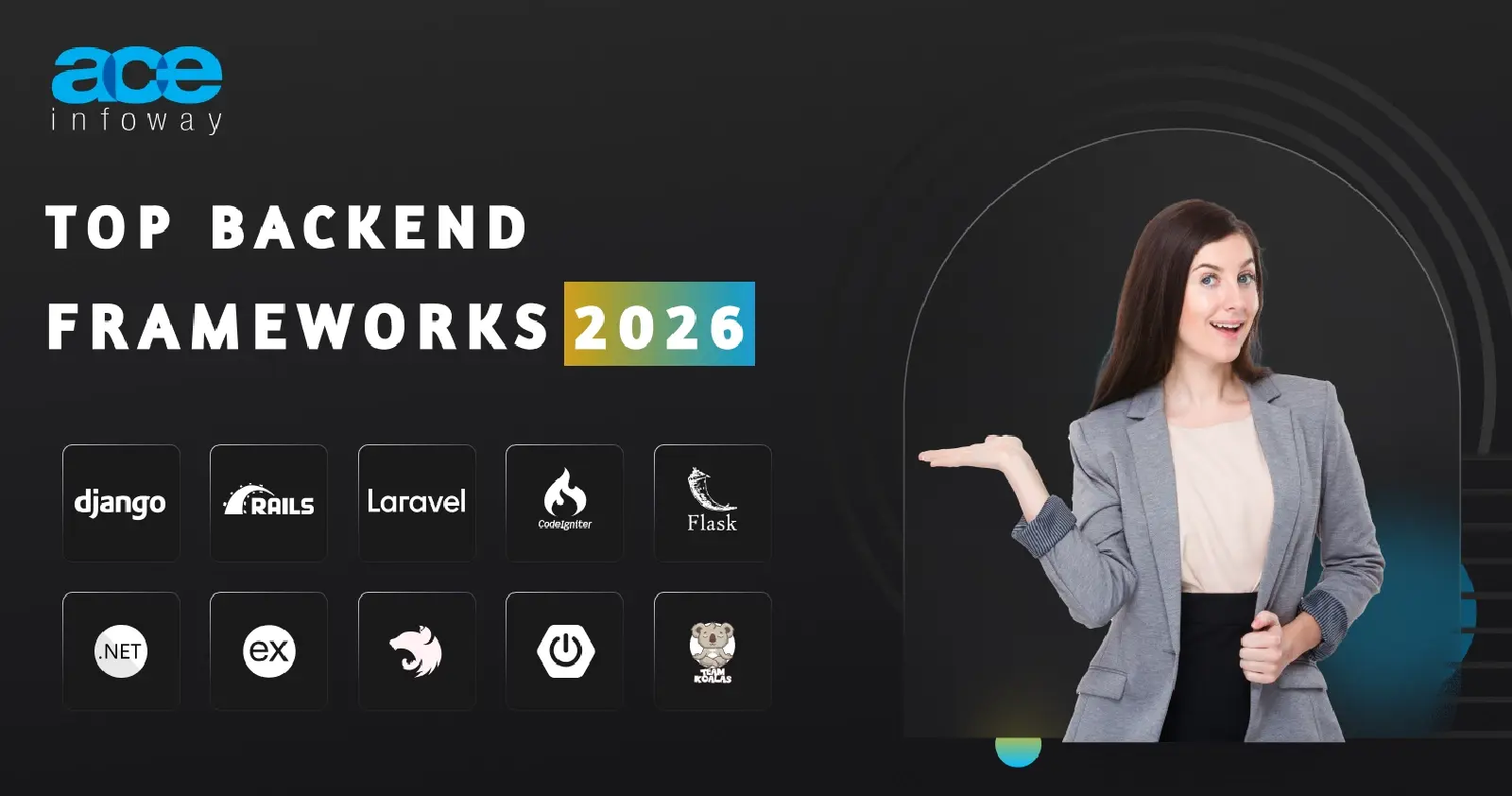
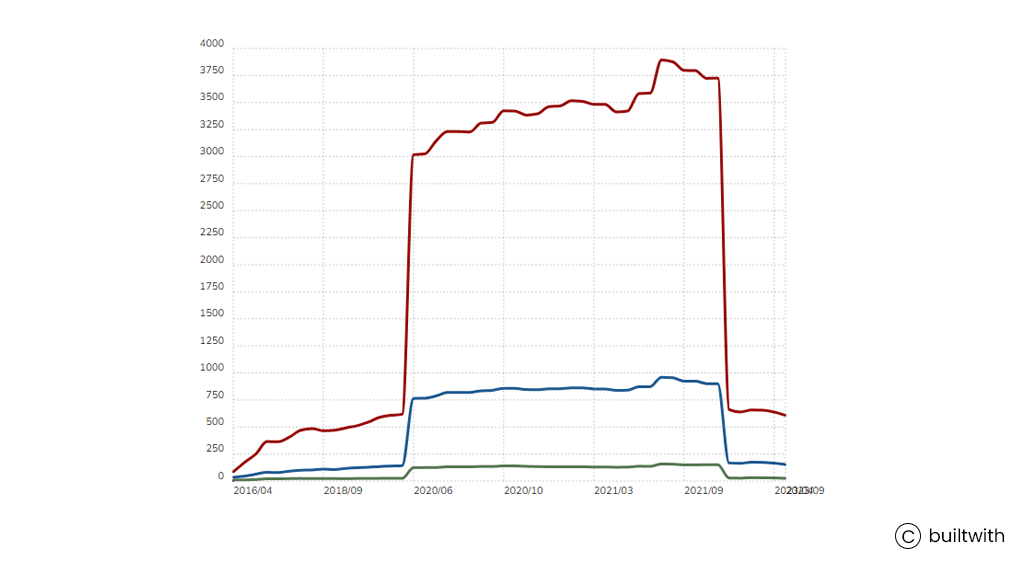

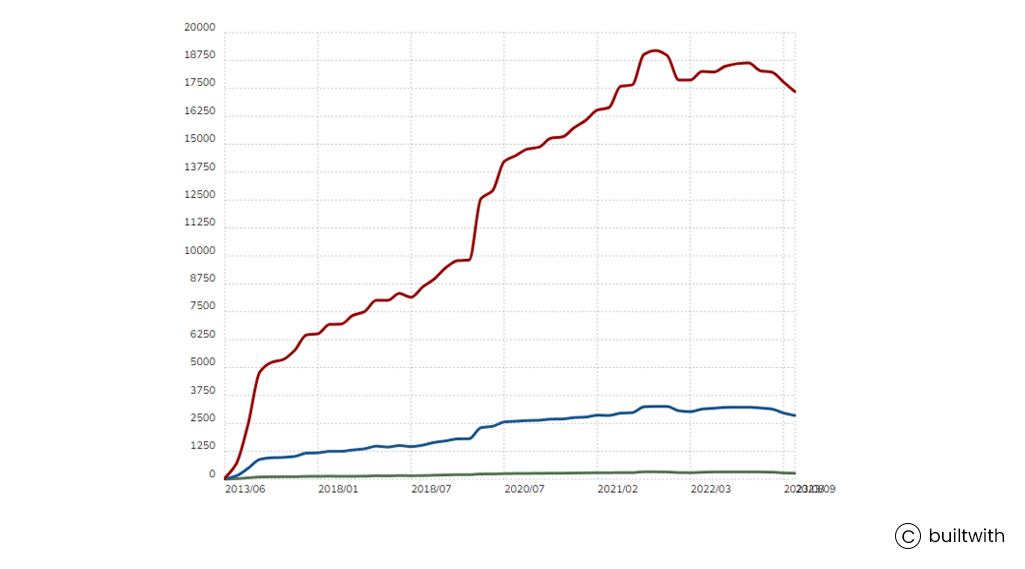
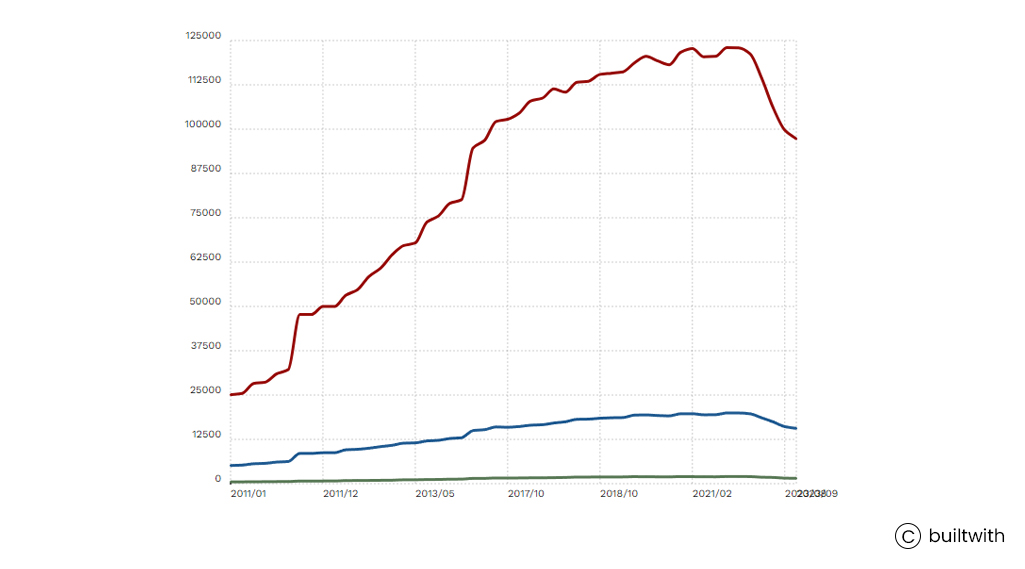


















Aw, this was an incredibly good post. Taking a few minutes and actual effort to generate a really good
article… but what can I say… I procrastinate a whole lot and don’t manage to get anything done.
Also visit my web site Additional Resources
I enjoy, lead to I discovered just what I used Go To This Web-Site be taking a look for.
You’ve ended my four day long hunt! God Bless you man.
Have a nice day. Bye